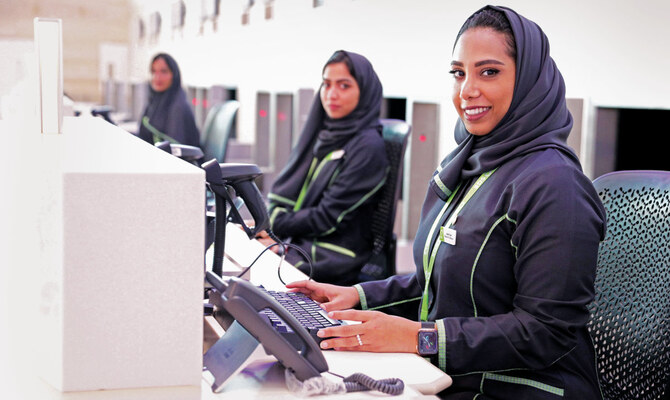RIYADH: From advanced technology to bustling tourism, Saudi Arabia is witnessing a labor market transformation that is reducing its reliance on oil and creating jobs in construction, green energy, and beyond.
Government initiatives such as the Saudi Nationalization Scheme and Nitaqat initiative have played a pivotal role in shaping the labor market landscape.
These policies have encouraged private sector employers to hire more of the Kingdom’s nationals across various industries, leading to a significant reduction in unemployment rates.
The commitment to enhancing workforce participation has also contributed to a more inclusive job market, while a strategic focus on developing a knowledge-based economy has led to increased investments in education and vocational training programs.
These initiatives are equipping the local workforce with the skills required to thrive in sectors such as advanced manufacturing, healthcare, and financial services, further accelerating employment growth.
Construction boom fuels job creation
The construction and infrastructure sector has experienced exponential growth in recent years, underpinning the Kingdom’s economic expansion, with contract awards in 2024 reaching $146.8 billion, a record high as it overtook 2023’s figure of $118.7 billion, according to Kamco Invest’s GCC Projects Market Update.
The report added that Saudi Arabia accounted for over 53.8 percent of total project awards across the Gulf Cooperation Council in 2024.
Sachin Kerur, managing partner of Middle East at Reed Smith, told Arab News that this boom is leading to a rise in the opportunities for project managers, designers, architects and many other construction professionals.
“Anyone studying Vision 2030 or visiting the important cities of the Kingdom will be very aware of the construction of large-scale housing, rail and road networks, new airports, infrastructure for major sporting events and industrial production plants,” Kerur said. Tourism-related construction has also seen a surge, with new hotels and resorts hiring more Saudi nationals. “Anyone visiting the Kingdom’s hotels of late will have noticed the number of Saudi nationals employed,” Kerur added.
Major projects such as the Rua Al-Madinah and Qiddiya are further fueling demand for skilled labor in the sector.

The Kingdom’s push to attract foreign investment has not only created job opportunities but also fostered knowledge transfer and skill development among the local workforce. (Shutterstock)
Tourism as a booster
The tourism sector continues to play a pivotal role in shaping Saudi Arabia’s labor market, and is only set to grow as the Kingdom pushes ahead with its aim to attract 150 million visitors annually by 2030. As a result, the demand for hospitality, transportation, and cultural service jobs is rapidly increasing.
“With millions of visitors anticipated to visit Saudi each year, tourism has one of the fastest growing and elastic demand for employment,” Kerur said.
From religious tourism initiatives in Makkah and Madinah to entertainment-driven projects such as the Red Sea Project, the sector’s expansion is creating thousands of jobs for Saudis.
Technology and green energy sectors see expansion
On a tech front, Saudi Arabia’s technology sector is experiencing unprecedented growth, driven by the government’s investments and incentives for global tech firms.
“Foreign investments are driving significant job creation in Saudi Arabia’s emerging industries, particularly technology and innovation, aligning with Vision 2030’s goals of economic diversification and private sector growth,” said Faisal Al-Sarraj, Saudi Arabia’s deputy country senior partner at PwC Middle East.
He continued: “PIF’s focus on technology and innovation has bolstered local employment, particularly in AI, digital transformation, and data analytics. Its support for startups and partnerships with global tech firms is strengthening local expertise.”
Initiatives such as the $100 billion AI and data analytics initiative, known as Project Transcendence, as well as smart city projects including NEOM, are fostering high-skilled employment in advanced fields.

Foreign investments are driving significant job creation in Saudi Arabia’s emerging industries.
Faisal Al-Sarraj, Saudi Arabia’s deputy country senior partner at PwC Middle East.
Citing media outlets Bloomberg and CIO, Al-Sarraj said: “This $100 billion plan positions Saudi Arabia as a global AI and data analytics hub, creating thousands of high-skilled jobs and rivaling regional tech leaders.”
The green energy sector is also taking off in Saudi Arabia, bringing a fresh wave of job opportunities and supporting the Kingdom’s sustainability goals.
Solar and wind farms are being developed across the country, creating thousands of new roles and giving locals the chance to dive into the world of clean energy.
Kerur also cited the life sciences and food industries as other sectors that have seen employment growth.
Saudi welcoming the world
The government’s Saudization initiatives, particularly the Nitaqat program which was established in June 2011, have played a crucial role in increasing the number of nationals in the private sector.
“Many commentators regard Saudization as having been most successful in the retail and tourism and hospitality sectors,” Kerur said.
He continued: “Perhaps less success has been achieved in areas such as life sciences, medicine and design and construction where more skilled resources are needed. That is certainly an area of development for the next few years.”
Moreover, the drive for greater workforce inclusion is also reflected in the increasing focus on supporting female participation in the labor market.
As more opportunities arise in flexible and remote work arrangements, women are stepping into roles across diverse sectors, contributing to the Kingdom’s broader economic transformation goals.
Figures released by the General Authority for Statistics showed that by the end of the third quarter of 2024 the labor force participation rate of Saudi females reached 36.2 percent — well above the original Vision 2030 target of 30 percent, with that goal now upped to 40 percent by the end of the decade.
Kerur added: “Saudi Arabia’s labor market reforms and initiatives are successfully reducing unemployment levels and so much credit must go to Vision 2030 as economic diversification develops at pace. However, this is not merely labour economics.”
He went on to say: “As with other GCC countries like the UAE, there are social and cultural norms that have to be assessed to ensure they are maintained whilst at the same time ensuring unemployment is minimised and the national workforce is equipped for the challenges of the next three decades.”
Regional Headquarters Initiative and FDI
One of the biggest wins for Saudi Arabia in 2024 was the success of its regional headquarters initiative, which has drawn in over 540 multinational companies to set up shop in the Kingdom.
This surge in corporate presence is not just about numbers — it is about turning Saudi Arabia into a thriving business hub, buzzing with new ideas and opportunities.
Companies such as Amazon, Google, PwC, and Deloitte have relocated their regional headquarters, leading to job creation in professional services, consulting, and administrative roles.
“This achievement is having an employment impetus as more and more companies are employing Saudi nationals in line with the Kingdom’s status as a developing business hub,” Kerur said.
The Kingdom’s push to attract foreign investment has not only created job opportunities but also fostered knowledge transfer and skill development among the local workforce.
With multinational firms bringing global best practices and expertise, Saudi nationals are gaining invaluable exposure to international business operations, positioning them competitively in the job market.
Another key initiative was the Golden Visa, which allows foreign nationals to live, work, and own property in the Kingdom without a sponsor,
In order to qualify, applicants must meet specific criteria such as significant investments in real estate or business ventures.
Al-Sarraj said the visa “incentivized” highly skilled professionals and entrepreneurs to relocate to Saudi Arabia, and has expanded employment in sectors such as healthcare, education, and technology, and fostered a knowledge-based economy.
He added: “Reforms like the Labor Reform Initiative improved mobility and flexibility for expatriates, making Saudi Arabia a more attractive job market. This policy also encouraged Saudization, driving the hiring of skilled nationals.”
Challenges and the road ahead
Despite the progress, challenges remain in bridging skill gaps and positioning manual labor or skilled trades as a viable career path for Saudis.
“Education and training will be vital all round for the labor market. Indeed more labor capacity is required to implement Vision 2030 projects and this provides Saudi nationals a significant opportunity to develop blue collar skills,” Kerur said.
He continued: “Of course the private sector, both national and international, will have a key role to play to train, develop and employ nationals. The issue will be the stick or the carrot.”
Kerur further explained that the private sector in Saudi Arabia will require support and assistance, particularly in areas where their capacity to operate or expand is currently limited, and where significant financial investment is needed.
“Saudi Arabia has shown a willingness to enable public private partnership in their labor market and more will be expected in this regard,” he said.
According to Al-Sarraj, one of the key issues is that many workers may not have received the necessary training and or hold the qualifications required by employers.
“Despite significant progress, challenges remain, including skill gaps among the workforce, the need for enhanced educational and vocational training programs, and ensuring sustainable employment opportunities for the growing local population,” he said.
Al-Sarraj added: “Employers often cite skill gaps and higher wage expectations as reasons for not hiring Saudis, highlighting the need for enhanced educational and vocational training programs.”
As Saudi Arabia’s labor market continues to evolve, the combined impact of strategic government initiatives, foreign investment, and workforce development efforts will be key to sustaining momentum.
With significant achievements in 2023 paving the way, the Kingdom is well-positioned to achieve its ambitious Vision 2030 objectives and create a dynamic, diversified workforce that meets future economic demands.





























